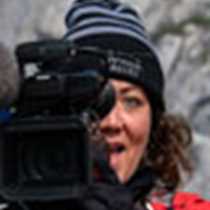Yes, you read that correctly. Due to favorable circumstances, our last full day in South Georgia combined two of the best landing sites this island has to offer. And, if that were not enough, the weather left us with rosy cheeks and a bead of sweat on our brows.
We kicked off today’s grand slam with a visit to Gold Harbour. This intimate, horseshoe-shaped bay is packed with life and rimmed with soft, undulating terrain, topped by saw-toothed mountains and all linked by a thin sliver of glacial ice. That sliver is known as the Bertrab Glacier and, for the past two years, two inconspicuous eyes have been watching its every move.
Perched almost a mile north and 500 feet up from our elephant seal-packed landing site are two orange boxes that contain time-lapse cameras installed by the Extreme Ice Survey (EIS) team in 2015. Conceived by National Geographic photographer James Balog and extended to the southern reaches of our planet with the help of Lindblad Expeditions, the EIS team is documenting the comings and goings of snow, seasons, penguins, seals and, as the name implies, ice in eight Antarctic locations including Gold Harbour.
For the past 730 days these two cameras have watched the life cycle of the same multitude of penguins we sat amongst today. They have, every two hours, opened their eyes just long enough (1/250th of a second) to watch the same elephant seal pups that have stolen our hearts enter this world (mid-October), take over the beach (Oct.-Dec.), head off on their own (early March) and, be replaced again by this year’s progeny.
Had we placed these two cameras at our afternoon landing site of St. Andrew’s Bay (20 miles to the south) they would have shown a similar progression of life. In this case they would have watched the island’s largest concentration of king penguins (100,000 nesting pairs) morph from a coastline dominated by black and white adults (March) to one dominated by brown chicks (May to August). Months before our arrival these cameras would have watched as these brown fluff balls shifted across the landscape like a giant amoeba—trying to stay warm and safe during the cold subantarctic winter while their parents were out at sea feeding.
While we were able to take in the overwhelming presence of hundreds of thousands of animals today it was also enlightening to collect the memory cards from the two aforementioned cameras at Gold Harbour. The 5,207 images gathered over the last year alone offer a rare glimpse into the life history of the animals that have been such a huge part of our experience here at South Georgia. May this combination of science and nature continue to broaden our appreciation and knowledge of the remote regions of our planet.









